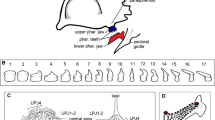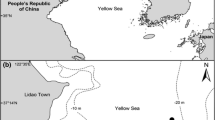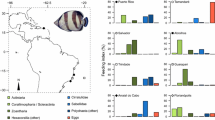Abstract
Many animals are considered to be specialists because they have feeding structures that are fine-tuned for consuming specific prey. For example, “smasher” mantis shrimp have highly specialized predatory appendages that generate forceful strikes to break apart hard-shelled prey. Anecdotal observations suggest, however, that the diet of smashers may include soft-bodied prey as well. Our goal was to examine the diet breadth of the smasher mantis shrimp, Neogonodactylus bredini, to determine whether it has a narrow diet of hard-shelled prey. We combined studies of prey abundance, feeding behavior, and stable isotope analyses of diet in both seagrass and coral rubble to determine if N. bredini’s diet was consistent across different habitat types. The abundances of hard-shelled and soft-bodied prey varied between habitats. In feeding experiments, N. bredini consumed both prey types. N. bredini consumed a range of different prey in the field as well and, unexpectedly, the stable isotope analysis demonstrated that soft-bodied prey comprised a large proportion (29–53 %) of the diet in both habitats. Using a Bayesian mixing model framework (MixSIAR), we found that this result held even when we used uninformative, or generalist, priors and informative priors reflecting a specialist diet on hard-shelled prey and prey abundances in the field. Thus, contrary to expectation, the specialized feeding morphology of N. bredini corresponds to a broad diet of both hard-shelled and soft-bodied prey. Using multiple lines of study to describe the natural diets of other presumed specialists may demonstrate that specialized morphology often broadens rather than narrows diet breadth.




Similar content being viewed by others
References
Ahyong ST (1997) Phylogenetic analysis of the Stomatopoda (Malacostraca). J Crustac Biol 17:695–715
Ahyong ST (2001) Revision of the Australian stomatopod Crustacea. Rec Aust Mus Suppl 26:1–326
Ahyong ST, Harling C (2000) The phylogeny of the stomatopod Crustacea. Aust J Zool 48:607–642
Ahyong S, Jarman S (2009) Stomatopod interrelationships: preliminary results based on analysis of three molecular loci. Arthropod Syst Phylogeny 67:91–98
Araújo MS, Bolnick DI, Layman CA (2011) The ecological causes of individual specialisation. Ecol Lett 14:948–958. doi:10.1111/j.1461-0248.2011.01662.x
Barnett A, Bellwood DR, Hoey AS (2006) Trophic ecomorphology of cardinalfish. Mar Ecol Prog Ser 322:249–257
Bearhop S, Adams CE, Waldrons S et al (2004) Determining trophic niche width: a novel approach using stable isotope analysis. J Anim Ecol 73:1007–1012
Bellwood DR, Wainwright PC, Fulton CJ, Hoey AS (2006) Functional versatility supports coral reef biodiversity. Proc R Soc B-Biological Sci 273:101–107
Binning SA, Chapman LJ, Cosandey-Godin A (2009) Specialized morphology for a generalist diet: evidence for Liem’s paradox in a cichlid fish. J Fish Biol 75:1683–1699. doi:10.1111/j.1095-8649.2009.02421.x
Blackwell PRY, O’Hara PD, Christy JH (1998) Prey availability and selective foraging in shorebirds. Anim Behav 55:1659–1667
Blanco MM, Patek SN (2014) Muscle trade-offs in a power-amplified prey capture system. Evolution 68:1399–1414. doi:10.1111/evo.12365
Bolnick DI, Yang LH, Fordyce JA et al (2002) Measuring individual-level resource specialization. Ecology 83:2936–2941
Bolnick DI, Svanbäck R, Fordyce JA et al (2003) The ecology of individuals: incidence and implications of individual specialization. Am Nat 161:1–28. doi:10.1086/343878
Brandl SJ, Robbins WD, Bellwood DR (2015) Exploring the nature of ecological specialization in a coral reef fish community: morphology, diet and foraging microhabitat use. Proc R Soc B Biol Sci 282:1–10
Burrows M (1969) The mechanics and neural control of the prey capture strike in the mantid shrimps Squilla and Hemisquilla. Z Vgl Physiol 62:361–381
Caldwell RL, Childress ML (1989) Prey selection and processing in a stomatopod crustacean. In: Hughes RN (ed) Behavioural mechanisms of food selection, vol. G 20 NATO ASI Series. Springer, Heidelberg, Germany, pp 143–164
Caldwell RL, Dingle H (1975) Ecology and evolution of agonistic behavior in Stomatopods. Naturwissenschaften 62:214–222
Caldwell RL, Dingle H (1976) Stomatopods. Sci Am 234:80–89
Caldwell RL, Steger R (1987) Effects of May, 1986 oil spill on gonodactylid stomatopods near Galeta Point. In: Jackson JBC, Cubit JD, Keller BD et al (eds) Short-term assessment of an oil spill at Bahia Las Minas, Panama. Smithsonian Tropical Research Institute, Panama City, pp 113–128
Caldwell RL, Roderick GK, Shuster SM (1989) Studies of predation by Gonodactylus bredini. In: Ferrero EA (ed) Biology of Stomatopods. Mucchi, Modena, pp 117–131
Chiaradia A, Forero MG, McInnes JC, Ramírez F (2014) Searching for the true diet of marine predators: incorporating Bayesian priors into stable isotope mixing models. PLoS ONE. doi:10.1371/journal.pone.0092665
Cubit JD, Windsor DM, Thompson RC, Burgett JM (1986) Water-level fluctuations, emersion regimes, and variations of echinoid populations on a Caribbean reef flat. Estuar Coast Shelf Sci 22:719–737. doi:10.1016/0272-7714(86)90095-8
Dalerum F, Angerbjörn A (2005) Resolving temporal variation in vertebrate diets using naturally occurring stable isotopes. Oecologia 144:647–658
Darwin C (1862) The various contrivances by which orchids are fertilised by insects. John Murray, London
Dearing MD (1993) An alimentary specialization for herbivory in the tropical whiptail lizard Cnemidophorus murinus. J Herpetol 27:111–114. doi:10.2307/1564920
deVries MS, Murphy EAK, Patek SN (2012) Strike mechanics of an ambush predator: the spearing mantis shrimp. J Exp Biol 215:4374–4384. doi:10.1242/jeb.075317
deVries MS, Martínez del Rio C, Tunstall TS, Dawson TE (2015) Isotopic incorporation rates and discrimination factors in mantis shrimp crustaceans. PLoS One 10:e0122334. doi:10.1371/journal.pone.0122334
Dingle H, Caldwell RL (1978) Ecology and morphology of feeding and agonistic behavior in mudflat stomatopods (Squillidae). Biol Bull 155:134–149
Dominguez JH, Reaka ML (1988) Temporal activity patterns in reef-dwelling stomatopods: a test of alternative hypotheses. J Exp Mar Bio Ecol 117:47–69
Dumont ER (1999) The effect of food hardness on feeding behaviour in frugivorous bats (Phyllostomidae): an experimental study. J Zool 248:219–229. doi:10.1111/j.1469-7998.1999.tb01198.x
Eilertsen MH, Malaquias MAE (2013) Unique digestive system, trophic specialization, and diversification in the deep-sea gastropod genus Scaphander. Biol J Linn Soc 109:512–525. doi:10.1111/bij.12069
Feranec RS (2007) Ecological generalization during adaptive radiation: evidence from Neogene mammals. Evol Ecol Res 9:555–557
Ferry-Graham LA, Bolnick DI, Wainwright PC (2002) Using functional morphology to examine the ecology and evolution of specialization. Integr Comp Biol 42:265–277. doi:10.1093/icb/42.2.265
Francis TB, Schindler DE, Holtgrieve GW et al (2011) Habitat structure determines resource use by zooplankton in temperate lakes. Ecol Lett 14:364–372. doi:10.1111/j.1461-0248.2011.01597.x
Franco-Trecu V, Drago M, Riet-Sapriza FG et al (2013) Bias in diet determination: incorporating traditional methods in Bayesian mixing models. PLoS One 8:1–8. doi:10.1371/journal.pone.0080019
Fry B (2006) Stable Isotope Ecology. Springer Science + Business Media, New York
Fry B, Arnold C (1982) Rapid 13C/12C turnover during growth of brown shrimp (Penaeus aztecus). Oecologia 54:200–204
Full RJ, Caldwell RL, Chow SW (1989) Smashing energetics: prey selection and feeding efficiency of the stomatopod, Gonodactylus bredini. Ethology 81:134–147
Futuyma DJ, Moreno G (1988) The evolution of ecological specialization. Annu Rev Ecol Syst 19:207–233
Gartner GEA, Greene HW (2008) Adaptation in the African egg-eating snake: a comparative approach to a classic study in evolutionary functional morphology. J Zool 275:368–374. doi:10.1111/j.1469-7998.2008.00448.x
Gelman A, Carlin JB, Stern HS, Rubin DB (2003) Bayesian Data Analysis, 2nd edn. Chapman and Hall, Boca Raton
Gordon ERL, Weirauch C (2015) Efficient capture of natural history data reveals prey conservatism of cryptic termite assassins. Mol Phylogenet Evol 94:65–73. doi:10.1016/j.ympev.2015.08.015
Grant PR (1986) Ecology and evolution of Darwin’s finches. Princeton University Press, Princeton
Grant BR, Grant PR (1993) Evolution of Darwin’s finches caused by a rare climatic event. Proc R Soc B Biol Sci 251:111–117. doi:10.1098/rspb.1993.0016
Hegrenes S (2001) Diet-induced phenotypic plasticity of feeding morphology in the orangespotted sunfish, Lepomis humilis. Ecol Freshw Fish 10:35–42. doi:10.1034/j.1600-0633.2001.100105.x
Hori M (1993) Frequency-dependent natural selection in the handedness of scale-eating cichlid fish. Science 260:216–219
Huang J, An J, Wu J, Williams PH (2015) Extreme food-plant specialisation in Megabombus bumblebees as a product of long tongues combined with short nesting seasons. PLoS One 10:1–15. doi:10.1371/journal.pone.0132358
Hulsey CD, De León FJG (2005) Cichlid jaw mechanics: linking morphology to feeding specialization. Funct Ecol 19:487–494
Kienle SS, Berta A (2015) The better to eat you with: the comparative feeding morphology of phocid seals (Pinnipedia, Phocidae). J Anat 396–413. doi: 10.1111/joa.12410
Konuma J, Nagata N, Sota T (2011) Factors determining the direction of ecological specialization in snail-feeding carabid beetles. Evolution 65:408–418. doi:10.1111/j.1558-5646.2010.01150.x
Lack D (1988) Darwin’s Finches. University of Cambridge, Cambridge
Lee SY (1995) Cheliped size and structure: the evolution of a multifunctional decapod organ. J Exp Mar Bio Ecol 193:161–176
Liem KF (1980) Adaptive significance of intraspecific and interspecific differences in the feeding repertoires of cichlid fishes. Am Zool 20:295–314
Lim SSL, Yong AYP, Christy JH (2016) Ontogenetic changes in diet and related morphological adaptations in Ocypode gaudichaudii. Invertebr Biol 135(2):117–126
Martínez del Rio C, Sabat P, Anderson-Sprecher R, Gonzalez SP (2009) Dietary and isotopic specialization: the isotopic niche of three Cinclodes ovenbirds. Oecologia 161:149–159. doi:10.1007/s00442-009-1357-2
Mateo MA, Serrano O, Serrano L, Michener RH (2008) Effects of sample preparation on stable isotope ratios of carbon and nitrogen in marine invertebrates: implications for food web studies using stable isotopes. Oecologia 157:105–115. doi:10.1007/s00442-008-1052-8
Mcgee MD, Borstein SR, Neches RY et al (2015) A pharyngeal jaw evolutionary innovation facilitated extinction in Lake Victoria cichlids. Science 350:1077–1079
Mehta RS (2009) Ecomorphology of the moray bite: relationship between dietary extremes and morphological diversity. Physiol Biochem Zool 82:90–103
Meyers JJ, Herrel A, Nishikawa KC (2006) Morphological correlates of ant eating in horned lizards (Phrynosoma). Biol J Linn Soc 89:13–24. doi:10.1111/j.1095-8312.2006.00654.x
Montaña CG, Winemiller KO (2013) Evolutionary convergence in Neotropical cichlids and Nearctic centrarchids: evidence from morphology, diet, and stable isotope analysis. Biol J Linn Soc 109:146–164. doi:10.1111/bij.12021
Moore JW, Semmens BX (2008) Incorporating uncertainty and prior information into stable isotope mixing models. Ecol Lett 11:470–480. doi:10.1111/j.1461-0248.2008.01163.x
Motta PJ (1988) Functional morphology of the feeding apparatus of ten species of Pacific butterflyfishes (Perciformes, Chaetodontidae): an ecomorphological approach. Environ Biol Fishes 22:39–67. doi:10.1007/BF00000543
Motta PJ, Clifton KB, Hernandez P, Eggold BT (1995) Ecomorphological correlates in ten species of subtropical seagrass fishes: diet and microhabitat utilization. Environ Biol Fishes 44:37–60. doi:10.1007/BF00005906
Newsome SD, Martínez del Rio C, Bearhop S, Phillips DL (2007) A niche for isotopic ecology. Front Ecol Environ 5:429–436
Newsome SD, Yeakel JD, Wheatley PV, Tinker MT (2012) Tools for quantifying isotopic niche space and dietary variation at the individual and population level. J Mammal 93:329–341. doi:10.1644/11-MAMM-S-187.1
Parnell A, Inger R, Bearhop S, Jackson A (2010) Source partitioning using stable isotopes: coping with too much variation. PLoS Biol 5:e9672
Parnell AC, Phillips DL, Bearhop S et al (2013) Bayesian stable isotope mixing models. Environmetrics 24:387–399. doi:10.1002/env.2221
Patek SN, Korff WL, Caldwell RL (2004) Deadly strike mechanism of a mantis shrimp. Nature 428:819–820
Patek SN, Nowroozi BN, Baio JE et al (2007) Linkage mechanics and power amplification of the mantis shrimp’s strike. J Exp Biol 210:3677–3688
Patek SN, Rosario MV, Taylor JRA (2013) Comparative spring mechanics in mantis shrimp. J Exp Biol 216:1317–1329
Phillips DL, Gregg JW (2003) Source partitioning using stable isotopes: coping with too many sources. Oecologia 136:261–269
Phillips DL, Koch PL (2002) Incorporating concentration dependence in stable isotope mixing models. Oecologia 130:114–125
Phillips DL, Inger R, Bearhop S et al (2014) Best practices for use of stable isotope mixing models in food-web studies. Can J Zool 835:823–835
Plummer M (2003) JAGS: a program for analysis of Bayesian graphical models using Gibbs sampling. In: Proceedings of the 3rd international workshop on distributed statistical computing. Vienna, Austria, pp 124–125
R Development Core Team (2014) R: a language and environment for statistical computing. R Foundation for Statistical Computing 1:409
Reaka ML (1975) Molting in stomatopod crustaceans. 1. Stages of molt cycle, setagenesis, and morphology. J Morphol 146:50–80
Rezac M, Pekar S, Lubin Y (2008) How oniscophagous spiders overcome woodlouse armour. J Zool 275:64–71. doi:10.1111/j.1469-7998.2007.00408.x
Rudman WB (1981) Further studies on the anatomy and ecology of opisthobranch molluscs feeding on the scleractinian coral Porites. Zool J Linn Soc 71:373–412. doi:10.1111/j.1096-3642.1981.tb01136.x
Sabat P, Maldonado K, Canals M, Martínez del Rio C (2006) Osmoregulation and adaptive radiation in the ovenbird genus Cinclodes (Passeriformes: Furnariidae). Funct Ecol 20:799–805
Saldaña-Vázquez RA, Ruiz-Sanchez E, Herrera-Alsina L, Schondube JE (2015) Digestive capacity predicts diet diversity in Neotropical frugivorous bats. J Anim Ecol 84:1396–1404. doi:10.1111/1365-2656.12383
Sanderson SL (1990) Versatility and specialization in labrid fishes: ecomorphological implications. Oecologia 84:272–279. doi:10.1007/BF00318284
Schluter D (2000) The ecology of adaptive radiation. Oxford University Press, Oxford
Semmens B, Ward E, Moore J, Darimont C (2009) Quantifying inter- and intra-population niche variability using hierarchical Bayesian stable isotope mixing models. PLoS One 4:6187
Stayton CT (2006) Testing hypotheses of convergence with multivariate data: morphological and functional convergence among herbivorous lizards. Evolution 60:824–841
Stock BC, Semmens BX (2013) MixSIAR GUI user manual, version 3.1. doi:10.5281/zenodo.47719
Van Valen L (1965) Morphological variation and width of ecological niche. Am Nat 99:377–390
Ward EJ, Semmens BX, Schindler DE (2010) Including source uncertainty and prior information in the analysis of stable isotope mixing models. Environ Sci Technol 44:4645–4650. doi:10.1021/es100053v
Warner GF, Jones AR (1976) Leverage and muscle type in crab chelae (Crustacea: Brachyura). J Zool 180:57–68. doi:10.1111/j.1469-7998.1976.tb04663.x
Weaver JC, Milliron GW, Miserez A et al (2012) The stomatopod dactyl club: a formidable damage-tolerant biological hammer. Science 336:1275–1280. doi:10.1126/science.1218764
Wilcox M, Rochette R (2015) Does claw morphology of the green crab Carcinus maenas vary in relation to its diet on rocky versus fine-sediment shores of southwest New Brunswick, Bay of Fundy, Canada? J Exp Mar Bio Ecol 465:121–129. doi:10.1016/j.jembe.2015.01.009
Wyatt AS, Waite AM, Humphries S (2010) Variability in isotope discrimination factors in coral reef fishes: implications for diet and food web reconstruction. PLoS One 5:e13682
Yamada SB, Boulding EG (1998) Claw morphology, prey size selection and foraging effecincy in generalist and specalist shell-breaking crabs. J Exp Biol Mar Ecol 220:191–211
Yeakel JD, Novak M, Guimarães PR et al (2011) Merging resource availability with isotope mixing models: the role of neutral interaction assumptions. PLoS One 6:1–8. doi:10.1371/journal.pone.0022015
Zack TI, Claverie T, Patek SN (2009) Elastic energy storage in the mantis shrimp’s fast predatory strike. J Exp Biol 212:4002–4009
Acknowledgments
We thank E. Gonzalez-Ulloa, F. Guerra, J. Morales, E. Staaterman, G. Thomas, T. Claverie, S. N. Patek, J. R. A. Taylor, R. L. Caldwell, D. Desmet, J. Hassen, A. Pickard, M. Limm, and M. E. Power and for assistance with study design, field work, and sample analysis. Fieldwork would not have been possible without I. Grenald and the staff at the Smithsonian Tropical Research Institute’s Galeta Point Marine Laboratory. We also thank S. Beissinger, R. L. Caldwell, J. Harris, S. Mambelli, A. Roddy, B. X. Semmens, M. I. Shuldman, T. S. Tunstall, P. C. Wainwright, and especially S. N. Patek for insightful discussion about data analysis and for comments on this manuscript. We thank J. Wortham and two anonymous reviewers for thoughtful comments on the manuscript. We are grateful for the use of the photograph in Fig. 1 from R. L. Caldwell. We thank the Autoridad Nacional del Ambiente in Panama for granting permits for this research (spring SEX/A-88-08, fall SEX/A-133-08). Research was funded by the American Museum of Natural History Lerner-Gray Fund, the Berkeley and National Sigma Xi Scientific Honors Society Grants-In-Aid-of-Research, the Fulbright Student Research Grant, the Society of Integrative and Comparative Biology Grants-In-Aid-of-Research, the Smithsonian Tropical Research Institute’s Short-Term Fellowship Award, the UC Berkeley Department of Integrative Biology Endowment, and the UC Museum of Paleontology Graduate Student Research Award (all awards to M. S. deVries), and a National Science Foundation Integrative Organismal Systems Grant (#1014573 to S. N. Patek). B.C. Stock was supported by the National Science Foundation Graduate Research Fellowship (DGE-1144086). Manuscript preparation was funded by the Phi Beta Kappa Graduate Fellowship (to M. S. deVries).
Author contribution statement
MSdV formulated the original idea. MSdV and JHC conceived and designed experiments. MSdV performed experiments. MSdV and TED performed stable isotope analyses. BCS analyzed the stable isotope data and MSdV analyzed the other datasets. GRG provided significant input on data analysis and interpretation. MSdV wrote the manuscript but BCS wrote the stable isotope statistical analysis methods and results. All authors contributed substantially to the interpretation of results and by giving critical conceptual and editorial advice.
Author information
Authors and Affiliations
Corresponding author
Ethics declarations
All applicable institutional and/or national guidelines for the care and use of invertebrates were followed.
Conflict of interest
The authors declare that they have no conflict of interest.
Additional information
Communicated by Craig A. Layman.
Electronic supplementary material
Below is the link to the electronic supplementary material.
Rights and permissions
About this article
Cite this article
deVries, M.S., Stock, B.C., Christy, J.H. et al. Specialized morphology corresponds to a generalist diet: linking form and function in smashing mantis shrimp crustaceans. Oecologia 182, 429–442 (2016). https://doi.org/10.1007/s00442-016-3667-5
Received:
Accepted:
Published:
Issue Date:
DOI: https://doi.org/10.1007/s00442-016-3667-5




